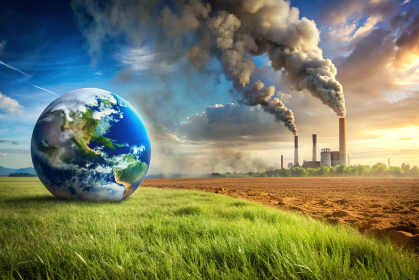Global Warming, Greenhouse Gas Effect and Carbon Footprint
Global warming, which is constantly on the agenda and one of our biggest concerns, can be defined as the increase in the average surface temperature of the Earth.
The main cause of global warming is the increasing greenhouse gas effect. While the greenhouse gas effect is caused by gases such as carbon dioxide (CO2), methane (CH4) and ozone (O3), one of the most effective greenhouse gases in the atmosphere is water. These gases, which have heat retention properties, accumulate in the atmosphere and reflect the sun's rays back to the surface of our planet, allowing heat to remain in the atmosphere. The greenhouse gas effect is essentially a natural and beneficial formation, heats our planet with the effect of rays from the sun, ensures that the temperature of the Earth remains in balance, and thus makes our planet livable.
However, nowadays, the Earth is heated by the rays reflected from the earth rather than the rays reflected from the sun. The reason for this is the deterioration of the natural greenhouse gas balance in the atmosphere and the increase in the amount of greenhouse gases. Greenhouse gases can occur due to natural and human reasons. Events such as volcanic eruptions and forest fires naturally lead to the formation of greenhouse gases. Human factors such as burning fossil fuels, gasoline consumption, deforestation and overconsumption are the main reasons for the emission of greenhouse gases.
Among greenhouse gases, there is the most carbon dioxide in the atmosphere. With the Industrial Revolution, fossil fuel consumption has started to increase and, accordingly, there has been a rapid increase in carbon dioxide density. Thus, this amount of emission remained above the natural cleaning amount of the earth and caused a serious problem such as global warming.
The main reason for the greenhouse gas emissions is carbon emissions and carbon footprint.

What is Carbon Emission and Carbon Footprint?
We all have a personal carbon footprint, and keeping it to a minimum is one of our most important responsibilities, both nationally and internationally. With this awareness of responsibility, we can reduce our carbon footprint to low levels with small changes in our daily lives.
The emission of carbon dioxide into the atmosphere caused by the use of fossil fuels such as coal, natural gas and oil is called carbon emission. The calculation of the increasing amount of greenhouse gases caused by companies and human activities in terms of carbon dioxide is called carbon footprint.
It is a method in which people or institutions measure how much they produce carbon due to different uses such as transportation, energy consumption, and waste production.
The carbon footprint is classified into two groups;
1) Primary Carbon Footprint: It is a measure of the energy consumption of people and institutions and the emission of carbon dioxide caused by the combustion of fossil fuels they have used.
2) Secondary Carbon Footprint: It is the measure of carbon dioxide emission in the process from the formation to the degradation of all products used by people and institutions.

Carbon footprint can be calculated both individually and institutionally and thus necessary precautions can be taken with environmental awareness.
Increased industrialization, the use of non-renewable energy sources, the increase in the use of motor vehicles, population growth, excess consumption, the increase in the amount of waste materials, the increased methane gas emissions due to the increase in meat consumption and livestock farming, and environmental pollution are the main reasons for the formation of carbon footprint. All these disrupt the balance of nature and create important environmental problems such as global warming, climate change, acid rain, drought.
What can we do to reduce our carbon footprint?
The use of motor vehicles should be reduced and public transport should be used as much as possible.
Renewable energy sources should be used in electricity consumption.
Attention should be paid to electricity and water saving.
Environmentally friendly recyclable products should be used.
Seedlings should be planted and green areas should be protected.
Domestic products should be preferred by avoiding excessive and unnecessary consumption.
Plastic packaging should not be preferred.
Most importantly, we should be aware of the issue for our future and raise awareness of those around us.
Hope to see you in our next post..